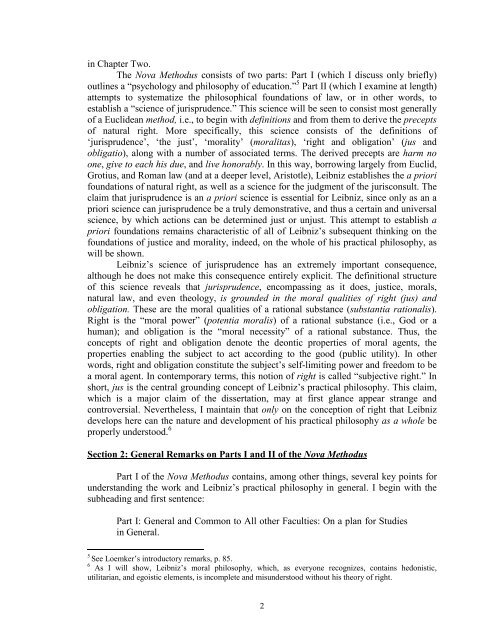Stony Brook University
Stony Brook University
Stony Brook University
You also want an ePaper? Increase the reach of your titles
YUMPU automatically turns print PDFs into web optimized ePapers that Google loves.
in Chapter Two.<br />
The Nova Methodus consists of two parts: Part I (which I discuss only briefly)<br />
outlines a “psychology and philosophy of education.” 5 Part II (which I examine at length)<br />
attempts to systematize the philosophical foundations of law, or in other words, to<br />
establish a “science of jurisprudence.” This science will be seen to consist most generally<br />
of a Euclidean method, i.e., to begin with definitions and from them to derive the precepts<br />
of natural right. More specifically, this science consists of the definitions of<br />
‘jurisprudence’, ‘the just’, ‘morality’ (moralitas), ‘right and obligation’ (jus and<br />
obligatio), along with a number of associated terms. The derived precepts are harm no<br />
one, give to each his due, and live honorably. In this way, borrowing largely from Euclid,<br />
Grotius, and Roman law (and at a deeper level, Aristotle), Leibniz establishes the a priori<br />
foundations of natural right, as well as a science for the judgment of the jurisconsult. The<br />
claim that jurisprudence is an a priori science is essential for Leibniz, since only as an a<br />
priori science can jurisprudence be a truly demonstrative, and thus a certain and universal<br />
science, by which actions can be determined just or unjust. This attempt to establish a<br />
priori foundations remains characteristic of all of Leibniz’s subsequent thinking on the<br />
foundations of justice and morality, indeed, on the whole of his practical philosophy, as<br />
will be shown.<br />
Leibniz’s science of jurisprudence has an extremely important consequence,<br />
although he does not make this consequence entirely explicit. The definitional structure<br />
of this science reveals that jurisprudence, encompassing as it does, justice, morals,<br />
natural law, and even theology, is grounded in the moral qualities of right (jus) and<br />
obligation. These are the moral qualities of a rational substance (substantia rationalis).<br />
Right is the “moral power” (potentia moralis) of a rational substance (i.e., God or a<br />
human); and obligation is the “moral necessity” of a rational substance. Thus, the<br />
concepts of right and obligation denote the deontic properties of moral agents, the<br />
properties enabling the subject to act according to the good (public utility). In other<br />
words, right and obligation constitute the subject’s self-limiting power and freedom to be<br />
a moral agent. In contemporary terms, this notion of right is called “subjective right.” In<br />
short, jus is the central grounding concept of Leibniz’s practical philosophy. This claim,<br />
which is a major claim of the dissertation, may at first glance appear strange and<br />
controversial. Nevertheless, I maintain that only on the conception of right that Leibniz<br />
develops here can the nature and development of his practical philosophy as a whole be<br />
properly understood. 6<br />
Section 2: General Remarks on Parts I and II of the Nova Methodus<br />
Part I of the Nova Methodus contains, among other things, several key points for<br />
understanding the work and Leibniz’s practical philosophy in general. I begin with the<br />
subheading and first sentence:<br />
Part I: General and Common to All other Faculties: On a plan for Studies<br />
in General.<br />
5 See Loemker’s introductory remarks, p. 85.<br />
6 As I will show, Leibniz’s moral philosophy, which, as everyone recognizes, contains hedonistic,<br />
utilitarian, and egoistic elements, is incomplete and misunderstood without his theory of right.<br />
2
















